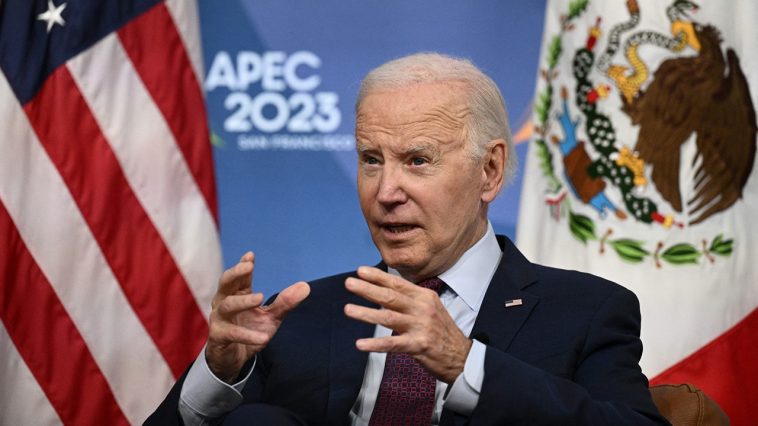LISTEN HERE:
The Biden government has been leaning heavily on a law initially designed to fortify national security, to implement its economic strategies, particularly in promoting green energy projects and boosting the production of certain goods to rectify economic matters.
Once again, the Defense Production Act (DPA) was brought into action by President Joe Biden in late November. Devised initially in 1950 amid the demands of the Korean War, the DPA empowers the president to regulate domestic industries indispensable for national security.
This recent invocation was to channel $35 million towards domestic manufacturing for certain medical components to tackle supply shortages, as the White House explained.
The repeated usage of the DPA is not without precedent. The previous administration under President Donald Trump expanded the use of the act during the coronavirus outbreak for increasing production of items essential to national health.
There has been a rising worry among economists about the frequent, expanded deployment of the DPA, as it seems to magnify executive power and extend government influence over areas not directly linked to national security.
In June 2022, President Biden utilized the DPA to grant the Department of Energy (DOE) the permission to funnel investments into facilities, manufacturing, processing components, and the implementation of green energy technologies.
In accordance with the DOE, this executive order spurred solar energy equipment, transformers, grid components, heat pumps, insulation, electrolyzers, fuel cells, and platinum-group metals production to meet carbon emission targets and lessen the dependence on foreign energy, particularly from antagonistic nations.
The global dominance of China in the clean technology supply chain cannot be ignored. In 2021, China was responsible for producing nearly 79% of the worldwide supply of polysilicon—a crucial constituent of solar panels—with 42% of that production emanating from Xinjiang, an area notorious for the use of Uighur forced labor by the Chinese government. Furthermore, China retained control over 90% of rare earth metals and produced a staggering 79% of all lithium-ion batteries in circulation in 2021.
Early in 2022, President Biden issued a formal determination empowering the Department of Defense (DOD) to intervene in private industries in order to aid in the mining and processing of strategic and critical components used in batteries essential to the burgeoning electric vehicle (EV) industry.
The objective was to foster a clean energy economy and clean energy supply chains, as recorded by DOD. Such a move was aimed at lessening the United States’ reliance on inconsistent foreign mineral sources pivotal for a shift towards green energy.
Despite the warmer-than-expected response from consumers, the EV industry continues to gain from government assistance in the form of both subsidies in the IRA and through strategic DPA interventions. Numerous automakers have experienced losses related to their attempts to venture into EV production, including Ford, which earlier estimated an operating loss of approximately $4.5 billion in 2023 alone for its electric Model e.
Additionally, in the face of a domestic shortage of infant formula, the Biden administration employed the DPA, mandating manufacturers to prioritize resources for the production of infant formula to enhance supply. As reported by a White House press release, this shortage was a result of a significant production facility being forced to close due to crucial safety and sanitary concerns.
Transcending health implications, Biden introduced the DPA once more in October to necessitate that tech corporations disclose essential data and safety test outcomes for their Artificial Intelligence (AI) systems. The explicit intention behind this move, according to a White House fact sheet, was to overturn AI models that might confront national security, economic stability, or public health.
The strategic use of the DPA has consistently been used to navigate the nation towards certain priorities set by the current administration. While the exact ramifications of this policy are multifaceted and complex, it has proven to be a powerful tool in the hands of the executive office.
This strategy, of course, raises pertinent questions about the extent of executive power and governmental involvement in sectors that aren’t traditionally seen as directly related to national security. The persistently expanding reach of the DPA seems to be blurring these traditional boundaries.
Possibly, one of the most significant concerns lies in the nation’s increasing dependence on China for the supply of green technology components. The glaring dominance of China in key aspects of green technology supply may create vulnerabilities, which is one of the issues the current administration aims to address via the DPA.
Especially noteworthy is the issuance of presidential determination giving the DOD the power to intervene in strategic sectors of the private industry. This move signals a shift towards a more proactive government involvement in industries that are vital for the nation’s mission to transition towards cleaner energy sources.
The re-routing of resources for the production of more ‘essential’ products, like baby formula, also raises a significant point about the extent to which the government can or should dictate industry priorities. It’s a delicate balance to strike, ensuring national needs are met without overstepping on the autonomy of the private sectors.
Moving forward, the frequent invocation of the DPA indicates a potential shift in the government’s policy and approach to national security, economic stability, and public health. This intersection points to an evolving understanding of what these terms mean in the 21st century.
The introduction of AI safety into the mix, indicates an acknowledgment of the expanding role of technology and AI systems in our national infrastructure and the protection thereof. In the era of digital information and warfare, the decision to include the regulation of AI shows a conscious movement towards fortifying not just the physical, but also the digital borders of the nation.
However, the wider ramifications of these actions are yet to be seen. More engagement from the government in areas traditionally left to the discretion of private sectors could provide benefits but also face potential backlashes. For instance, how these new technological directives align with the current narrative of economic competition and national security will be something to watch for.



